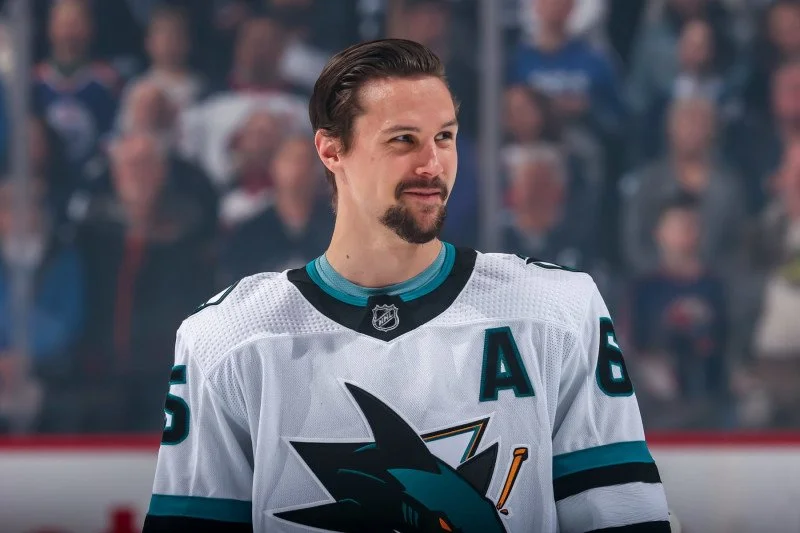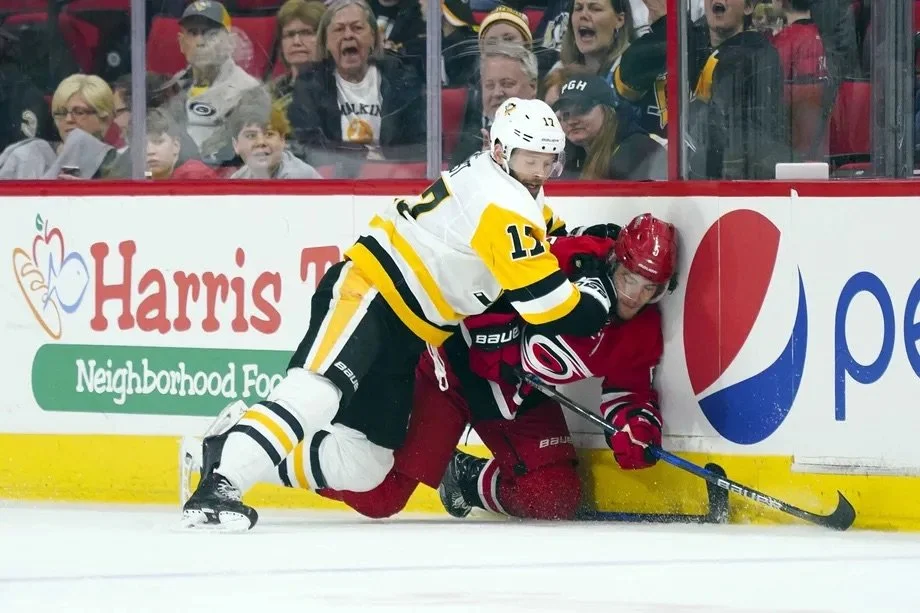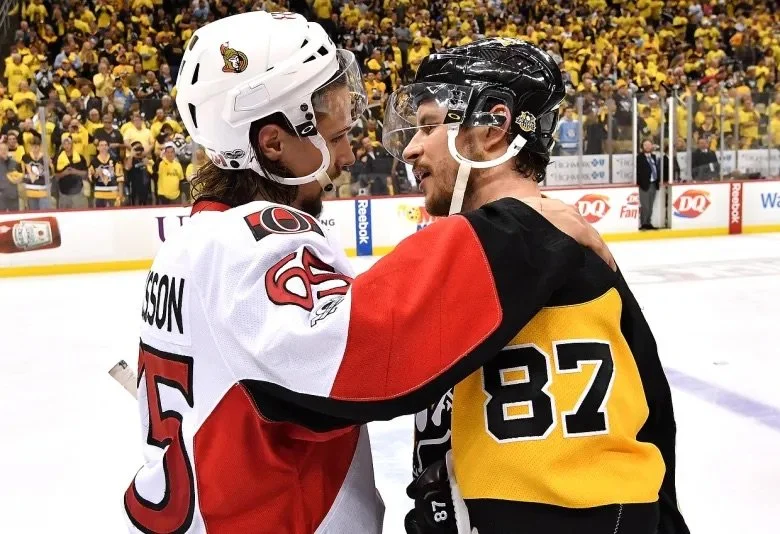Why An Erik Karlsson Trade to the Penguins Makes Sense
Jonathan Kozub/Getty Images
PITTSBURGH - The biggest trade in the National Hockey League over the past decade was arguably the Erik Karlsson trade from the Ottawa Senators to the San Jose Sharks before the 2018 season. History seems bound to repeat itself, as rumors have been swirling since last season’s trade deadline that Karlsson would leave the Bay Area. Around that time, the Edmonton Oilers were odds-on favorites to land the Swedish defender. No deal came to fruition, and now that the offseason is underway, a deal is easier to complete and seems more likely than ever to commence. From the sounds of it, the sweepstakes are down to two teams, both hailing from the Metropolitan Division: the Carolina Hurricanes and the Pittsburgh Penguins.
I’ve talked at length with friends and colleagues about the potential of a Karlsson to Pittsburgh trade, and after much deliberation, I’m on board with it.
Erik Karlsson is fresh off of the best offensive season from a defenseman in over three decades. The last defender to break the 100-point barrier was Brian Leech in the 1991-92 season. Karlsson took home his third career James Norris Memorial Trophy for best defenseman in the league. It had been eight seasons since his previous time winning the award, and eleven years since his first time.
Since the start of his Hall-of-Fame career, Karlsson has had to go through more hardships than most people have to in a lifetime, both on and off the ice. Karlsson has come back from numerous career-threatening injuries, including an Achilles tear in 2013 that occurred against the Penguins. In 2018, Karlsson and his wife were expecting their first child when they were given the worst news prospective parents could receive, that their child would not make it. Just months later, Karlsson and his wife were allegedly harassed by the significant other of one of Erik’s teammates on the Senators, including remarks made about their stillborn child.
Following that season, Karlsson was sent to San Jose in a massive trade package. Karlsson would sign an extension to make him the highest-paid defender in the NHL. While in San Jose, Karlsson would perform well to start, but injuries would start to catch up with him. In his first four years in Northern California, he would not play more than 56 games in any season.
Karlsson’s style of play relies on him controlling the puck. His production took a notable dip during the start of his tenure with the Sharks, as they had another defender who played a similar style as Karlsson, Brent Burns. Last offseason, San Jose shipped Burns to Carolina, paving the way for Erik Karlsson to pop off offensively, and he did.
The 2022-23 San Jose Sharks finished 25th in goals scored as a team. Karlsson, individually, finished eleventh in points amongst all skaters in the league and tied for third in assists. Amongst Sharks, Karlsson had 34 more points than the second-highest scoring player, 35 more assists than the second-best setup man, and finished just two goals shy of the team lead in goals. This type of production from a defenseman on such a bad team is unprecedented.
While unprecedented, observers shouldn’t have been as surprised as they were. When healthy, Karlsson would flirt with a point-per-game in seasons past. The difference this time was everyone assumed Karlsson was trending negatively and past his peak of dominance, while also being on a team that both offensively and defensively was a blackhole.
This time last year, there were conversations about how the Sharks could feasibly get another team to take Karlsson and his anchor of a contract off of their roster. Suggestions included having the Sharks possibly attach a first-round pick in a deal along with Karlsson, just to be rid of him. Instead, GM Mike Grier held onto the Swedish legend and now seems ready to finally make a deal to improve his Sharks team.
As I mentioned, all indications are pointing to this being a two horse race between the Hurricanes and Penguins. At the moment, the Hurricanes have two legitimate advantages over the Penguins in the race to acquire Karlsson.
James Guillory/USA TODAY Sports
First, the Hurricanes have more cap space than the Penguins. According to CapFriendly, the Hurricanes currently have around $3.3 million in cap space with 11 forwards, seven defenders, and three goalies under NHL contract. The Penguins currently sit at nearly $1.5 million over the salary cap ceiling with 12 forwards, seven defenders, and three goalies on the NHL roster. Since they’re over the limit, and the roster obviously isn’t complete, it's clear that Dubas has some more moves planned.
The one caveat to this is that there is a presumed deal agreed upon between the Philadelphia Flyers and the Hurricanes for D Tony DeAngelo at about 50 percent of his salary retained. It was reported before the draft, but due to rules regarding trading a player back to their previous team on a salary-retained deal, the finalized trade had to wait until later this week. DeAngelo’s cap hit is $5 million, so if Carolina gets him at $2.5 million and they don’t send the Flyers any of their roster players, expect their cap space to reach roughly $800,000.
Even at $800,000 in cap space, the Hurricanes are more financially free to complete a Karlsson deal than the Penguins.
The other advantage Carolina has over Pittsburgh is tradable young assets. Whether it's prospects who are a ways away from being in the NHL, or young contributing NHL pieces, Carolina is leaps and bounds better than Pittsburgh. According to Byron Bader of Hockey Prospecting, Carolina’s prospect pool ranks 11th in the league, while Pittsburgh’s sits at 29th.
On the NHL roster, Carolina has an average age of 28.3 years old, including numerous proven young players such as F Martin Necas, F Seth Jarvis, F Jack Drury, D Dylan Coghlan, and G Pyotr Kochetkov, among others. Pittsburgh’s average age on their roster is 31 years old, with no notable contributor under the age of 27 beyond D Pierre-Olivier Joseph.
Based on those two important factors, Karlsson makes much more logical sense for Carolina than Pittsburgh. It’s a much easier fit for the Hurricanes to make than Kyle Dubas and the Penguins. However, I still think a Karlsson trade makes the most sense for the Penguins.
Karlsson Fits in with the Penguins Timeline
On May 31, Erik Karlsson turned 33 years old. He has four seasons remaining on his contract with San Jose, which will take him to age 37. The three-headed monster in Pittsburgh is right in that wheelhouse as well, both in age and years left on contracts.
C Sidney Crosby is 35 years old and turns 36 prior to the start of next season. He has two years remaining on his contract, taking him to age 38. He stated at the beginning of this past season on the 32 Thoughts Podcast that he intends to play for three more seasons, then consider his options.
C Evgeni Malkin is 36 and turns 37 later this month. He has three seasons remaining on his extension that he signed last offseason, just hours before being able to test the free agent market for the first time in his career. That deal takes Malkin to age 39.
D Kris Letang turned 36 in April. There are five years remaining on his extension that he signed last offseason, too. His deal runs out after he turns 41 in 2028.
The Penguins' window is shutting. The time to go for it is right now. There likely won’t be a player of Karlsson’s caliber that becomes available on the trade market during the remainder of the Crosby/Malkin/Letang era. His contract and age roughly go right along with those three. Penguins hockey will likely be dull following their departure (even more dull if this trade goes through), but the organization owes it to them to give them one last kick at the can. Karlsson gives them that opportunity.
For Carolina, they will likely be in contention for years to come, with or without Karlsson. In fact, if they move their young pieces to acquire him, chances are their window closes sooner than it would without him. Because of this, Pittsburgh is likely more motivated to pull the trigger on this deal than Carolina.
Jamie Sabau/Getty Images
Karlsson Gets to Play with other Hall-Of-Famers for the first time in his career
Despite being an elite defender throughout most of his 14-year NHL career, Karlsson has only played playoff hockey in six seasons. Of those six seasons, only two were actually deep runs in the playoffs that got him close to a chance to play for Lord Stanley.
In the 2016-17 season, Karlsson was on a tear in the playoffs. He carried a fairly underwhelming Senators roster to the third round, where they met the reigning and soon-to-be-again Stanley Cup Champions, the Pittsburgh Penguins. Karlsson put up 18 points in 19 playoff games on that run. Ottawa was a goal away from making it to the finals before Chris Kunitz blasted home a one-timer past G Craig Anderson in double overtime to end the series.
His only other taste of playoff success came in his first season in San Jose, 2018-19. The Sharks made it to the conference finals, where they met their match with the St. Louis Blues, who were en route to their first Stanley Cup in franchise history. Karlsson again proved to show up in the big-time moments, scoring 16 points in 19 playoff games. That year’s team was the most talented roster Karlsson had been a part of in his career. He missed 29 regular season games that season due to injury.
Unfortunately for Karlsson and the Sharks, that was the only successful season for the team since acquiring him. The team lost many key players from that run, including F Joe Pavelski, C Joe Thornton, F Evander Kane, and more recently, D Brent Burns and F Timo Meier. The roster Karlsson currently resides on is not the one he signed up for when he signed his extension in 2019.
If he joined the Penguins he would finally be surrounded by peers of his level. He would presumably quarterback a power play unit that consists of, at minimum, three future Hall-of-Famers, and maybe even four if head coach Mike Sullivan can find a spot for D Kris Letang on that top unit.
Following an underwhelming season, Penguins fans need this
Penguins fans are seasoned to have high expectations of their teams. Missing the playoffs, especially in an era with as many legends on the roster as this team, is not acceptable. While the inevitable slowly became reality this past season, Penguins fans were vocal. Countless times at PPG Paints Arena during the second half of the season, the team was peppered with “Fire Hextall” chants. The fanbase knew what the problem was; a general manager who was unwilling to make improvements to create a winning team, eventually leading to a wasted year for these great players.
Ever since Lemieux was drafted, the fanbase has come to expect the team to collect superstars when possible. The history of the Penguins isn’t told with 2-1 victories and a collection of a few good players. It includes acquiring superstars who were icons of the sport, and legends in the city. In that era, the Penguins added C Ron Francis, D Paul Coffey, D Larry Murphy, F Joe Mullen, G Tom Barrasso, and even F Luc Robitaille. Even though Robitaille’s time in Pittsburgh was short, you can still find Robitaille jerseys walking around the concourses of PPG Paints Arena to this day.
During the Crosby era, past GMs weren’t shy to bring on elite, superstar talent either. F Mark Recchi, F Marian Hossa, F Jarome Iginla, and F Phil Kessel were all superstars that were brought in to help push the team into deeper playoff contention. Undoubtedly, a Karlsson acquisition would be the biggest deal of the Crosby era.
If there’s anything we’ve learned from the Vegas Golden Knight's recent championship, the method of collecting superstars like Thanos collected Infinity Stones can win a team a Stanley Cup. I wonder if Kyle Dubas agrees.
There is a Template of a Karlsson Trade that Makes Sense for Pittsburgh
Despite making the point that the deal financially fits the Hurricanes easier than the Penguins, there’s a template for a deal that makes sense. D Jeff Petry was reported to have drawn interest from the San Jose Sharks early in the draft week. Petry is an offensively-minded, right-shot defender. There’s no reality where the Penguins acquire Karlsson and hold onto Petry. It’s redundant and makes too much sense financially to move on from him. Petry makes $6.25 million for the next two seasons.
In addition to Petry, likely being pushed out the door in a Karlsson deal is F Mikael Granlund. Granlund was Ron Hextall’s sad attempt at improving this team at the trade deadline. He overpaid for the player, sending a second-round pick for him. Granlund looked completely out of place during his short stint with the Penguins, scoring well below his career point pace. Granlund makes $5 million for the next two seasons.
Petry and Granlund’s cap hits combined are $11.25 million. Karlsson’s cap hit sits at $11.5 million right now. My expectation is, if a deal with Pittsburgh gets done, there is some retention on Karlsson’s deal, either by San Jose or a third team. In addition, both of those players would be sent out, either to San Jose or again to the third team. It would have to be enough retention to not only allow for the difference in $250,000 but also the roughly $1.5 million the team is over the salary cap by unless Dubas has additional moves planned to alter the roster.
Also, given Karlsson’s newfound trade value from his historic season, at minimum, a first-round pick is sent from the Penguins to the Sharks. I wouldn’t be surprised if San Jose saw value in a player like D Pierre-Olivier Joseph and would take a flier on him, as well. Could prospects D Owen Pickering or F Sam Poulin be added? Maybe. But teams tend to lean towards the picks over the prospects since they have the choice to select their own guys, instead of being fed whatever the other team feeds them.
If a third team is involved, expect Pittsburgh to have to pay them assets as well to retain the salary cap on Karlsson’s deal for each of the next four seasons. There haven’t been many three-team trades recently where a third team retained salary, so it’s unknown what the going rate is for retention. Could a second-round pick and a fourth-round pick be worth $2 million for the next four years? Is that too much or too little? No one really knows other than the executives who are cooking up the Erik Karlsson deal right now.
My point in writing this was to convince you, as well as myself, that Erik Karlsson could feasibly become a member of the Pittsburgh Penguins, and it could work out fine. When I first heard the rumor, I didn’t believe it. Then when it became more real, I didn’t like the idea of it. Karlsson with Letang can seem as redundant as Karlsson with Burns. Karlsson makes a lot of money for four more seasons, and has a history of some gruesome injuries that could cause future performance issues. I see that argument. I see many reasons why it could end up not working for the Penguins.
But, why not? Sports are supposed to be fun, and nothing sounds more fun and exciting than Erik Karlsson playing alongside Sidney Crosby, Evgeni Malkin and Kris Letang. Josh Yohe of The Athletic reported that Dubas was close on July 1 to a deal for Karlsson. Other reporters have kept the dream alive for Penguins fans by dropping tidbits every couple days, stating the Penguins are favorites to acquire Karlsson.
Pull the trigger, Kyle. Make it happen.


